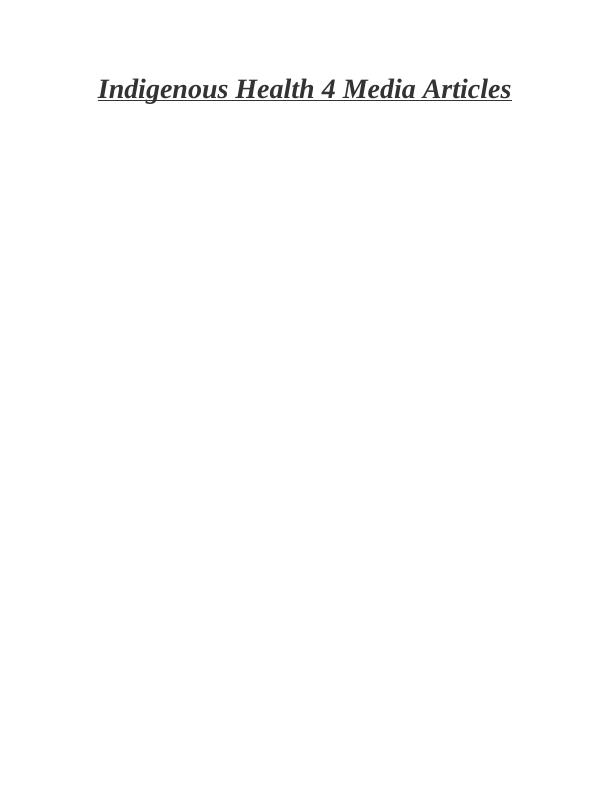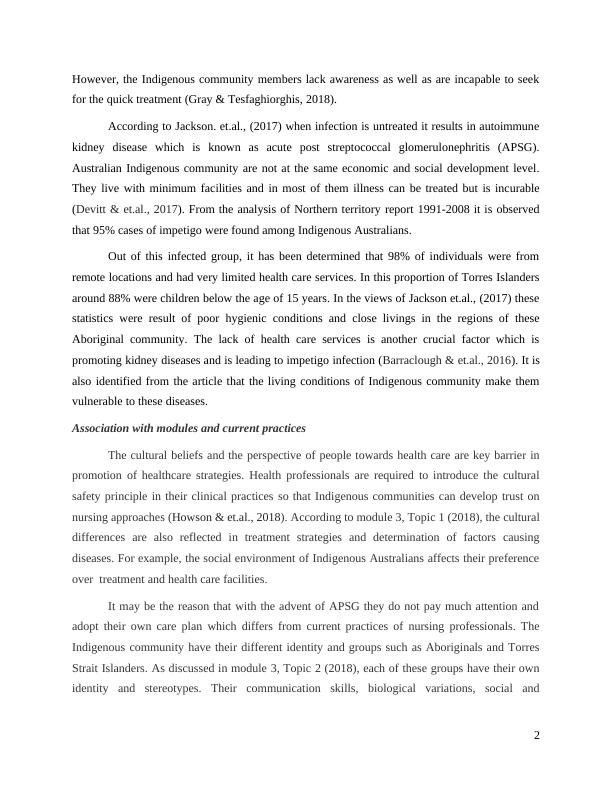Ask a question from expert
Health Status of Indigenous and Non-Indigenous Population
13 Pages4499 Words207 Views
Added on 2020-11-23
Health Status of Indigenous and Non-Indigenous Population
Added on 2020-11-23
BookmarkShareRelated Documents
Indigenous Health 4 Media Articles

TABLE OF CONTENTSMedia portfolio................................................................................................................................1INTRODUCTION..........................................................................................................................1Media item 1: “Why simple school sores often lead to heart and kidney disease inIndigenouschildren”........................................................................................................................1Media item 2: “ Indigenous patients in need of new kidneys aren’t getting a fair go ”..................3Media item 3: “Institutionalised racism, reason for fewer Indigenous kidney transplants”............5Media item 4: “Remote kidney clinic heralds a homecoming for Aboriginal patients after yearsspent away”......................................................................................................................................7CONCLUSION ...............................................................................................................................9REFLECTION ..............................................................................................................................10

Media portfolioHigh risk of kidney diseases among Indigenous population of Australia and determinantscontributing lower rate of kidney transplantation among Aboriginal community (Paradies, 2016).INTRODUCTIONAboriginal children are more likely to develop kidney diseases as compare to non-Indigenous community of Australia. Only a small percentage of Indigenous people who sufferedfrom kidney related issues undergo kidney transplantation. The health related factors ofIndigenous Australians are influenced by the factors like social structure, wealth, power andliving conditions (Australian Institute of Health and Welfare 2015). However, discrimination andeconomic considerations plays vital role in determining lack of aces of Torres islander overhealth care services. The report will analyse four different media articles which will highlight the portfolio.Through media resources the report will evaluate the causes which limits equal chances ofIndigenous Australians for kidney transplantation. It will also discuss that how Aboriginalpatients spent years away from their family just because of remote clinics which provides kidneyservices. Media item 1: “Why simple school sores often lead to heart and kidney disease inIndigenouschildren”Jackson, T. Erin, W. Gregory, P. & Nathan, M.C (2017). Why simple school sores often lead toheart and kidney disease in Indigenouschildren. Retrieved fromhttps://theconversation.com/why-simple-school-sores-often-lead-to-heart-and-kidney-disease-in-indigenous-children-86066Key issues identified in media article The article describes the impact of impetigo or school sores on kidney related health ofchildren. School sores is one of the most common bacterial skin infection. It results in abscess,acute rheumatic fever or chronic kidney diseases. The underprivileged populations are morevulnerable to this risk. Jackson. et.al., (2017) presents fact that around 40% of Indigenouschildren are expected to suffer from the different types of infection. The infections arecontagious therefore it is essential for the individuals to maintain the good hygiene conditions.1

However, the Indigenous community members lack awareness as well as are incapable to seekfor the quick treatment (Gray & Tesfaghiorghis, 2018). According to Jackson. et.al., (2017) when infection is untreated it results in autoimmunekidney disease which is known as acute post streptococcal glomerulonephritis (APSG).Australian Indigenous community are not at the same economic and social development level.They live with minimum facilities and in most of them illness can be treated but is incurable(Devitt & et.al., 2017). From the analysis of Northern territory report 1991-2008 it is observedthat 95% cases of impetigo were found among Indigenous Australians. Out of this infected group, it has been determined that 98% of individuals were fromremote locations and had very limited health care services. In this proportion of Torres Islandersaround 88% were children below the age of 15 years. In the views of Jackson et.al., (2017) thesestatistics were result of poor hygienic conditions and close livings in the regions of theseAboriginal community. The lack of health care services is another crucial factor which ispromoting kidney diseases and is leading to impetigo infection (Barraclough & et.al., 2016). It isalso identified from the article that the living conditions of Indigenous community make themvulnerable to these diseases. Association with modules and current practices The cultural beliefs and the perspective of people towards health care are key barrier inpromotion of healthcare strategies. Health professionals are required to introduce the culturalsafety principle in their clinical practices so that Indigenous communities can develop trust onnursing approaches (Howson & et.al., 2018). According to module 3, Topic 1 (2018), the culturaldifferences are also reflected in treatment strategies and determination of factors causingdiseases. For example, the social environment of Indigenous Australians affects their preferenceover treatment and health care facilities.It may be the reason that with the advent of APSG they do not pay much attention andadopt their own care plan which differs from current practices of nursing professionals. TheIndigenous community have their different identity and groups such as Aboriginals and TorresStrait Islanders. As discussed in module 3, Topic 2 (2018), each of these groups have their ownidentity and stereotypes. Their communication skills, biological variations, social and2

End of preview
Want to access all the pages? Upload your documents or become a member.